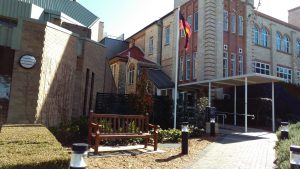Edition Seven SRO The Best Of 2017
Welcome to the final edition : The Best of 2017 from Year 9 SRO
Are We Actually Prepared
Flynn Mooney
Newington ran another of its infamous lockdown and evacuation drills on Wednesday, and it can’t be said that it was a complete success. The most notable issue was that not all of the rooms and buildings in the school are fully equipped with a working alarm.
Year 9 boys working on sports journalism in the OBLT were left unknowing to the drills, as there was no lockdown or evacuation alarms heard. I caught up with a student from that class, Harrison Henson, who had this to say, “no one in the class even knew what was going on, until our teacher walked out to get something and came back and said everyone was on the oval. If there was actually a man on campus or a fire, we surely would have been killed.”
The chilling truth is that these students would have been in very serious danger if there was a realistic threat, and this is just unacceptable.
It has also been confirmed there was a second class who did not here the alarms, and would have been in similar danger in a real lockdown or evacuation. However, this is not the only issue revolving around these practice drills.
Another problem is the lay out of the rooms in regards to the ability to see in and around from the outside. If there was someone on campus who got into the building, students inside most classrooms are still very visible, even if they are on the ground and the lights are turned off.
This raises the danger level for the students, as visibility in the classroom is key for an emergency. While there isn’t a clear solution at the moment, this issue should be looked at for future classes.
Indigenous Flag in Pole Position
Correspondent Edward Dam
In the NAIDOC Assembly, it was announced that the Aboriginal flagpole next
to the Chapel would be a permanent fixture. Erected in time for NAIDOC Week, the flag is intended to be a constant reminder to students of the struggles faced by Indigenous people and their role in Australia.
The placement of the flag has attracted some attention since its installation over the holidays. It is located within the Chapel grounds, in front of the Chapel building itself and next to the
Le Couteur building. However, it is the furniture next to the flag that has ruffled feathers for some.
Next to the flagpole, there is a bench on a platform of bricks.
These bricks,gifted to the school in celebration of Australia’s Bicentenary in 1988, are from the cottage at Vernals Farm, Lyndhurst, Hampshire, Great Britain. According to the plaque on the bench, this rural dwelling was “where Captain Arthur Phillip lived before commanding
the First Fleet”.
Captain Arthur Phillip, born on 11 October 1738 in Allhallows, Kent, England,
began service in the Royal Navy since he was 17, rapidly rising from the rank of Ordinary Seaman on HMS Buckingham at the time of his enlistment to eventual position of Admiral. He saw action in the Seven Year’s War and joined the Portuguese Navy with the Admiralty’s permission for the Spanish-Portuguese War. His long and distinguished career led to his appointment as commodore of the First Fleet and Governor in Chief of His Majesty’s Penal Colony of New South Wales by Lord Sydney, Secretary of State for the
Home Office and namesake for the cove in which Phillip would establish his fledgling outpost.
I contacted the Newington leadership for comments about the apparent misplacement of the flag. Mr Steve Muir, in charge of the NAIDOC celebrations, specifically asked Dr David Mulford, Headmaster
of the school, for permission to erect the Aboriginal Flag. “I have always wanted the Aboriginal Flag to be a permanent fixture in the College”, he stated. “Dr Mulford and Mr Roberts agreed that it is extremely important to acknowledge the original custodians
of the land”.
I also managed to get in touch with the Headmaster himself. He gave a lengthy
statement, revealing that the flag placement in the Chapel grounds was “most apt given our Newington ethos of respecting everyone’s search for a spiritual dimension”. He also elaborated on the decision to specifically place the flag next to the seat.
“I am sure Governor Phillip would be chuffed to have an Indigenous acknowledgement…Historians tend to agree that Phillip initially sought friendly relations with the Eora nation”, he stated.
The Head of History, Mr Peter Reid, also agrees that Phillip was a man of conscience. “Both he and our 5th Governor, Lachlan Macquarie, were staunch opponents of slavery”, he noted.
The first Governor is widely regarded as being ahead of his time with the treatment of his subjects. Not only did he abolish slavery in the new colony 20 years before the rest of the British Empire followed suit, he also promoted emancipation for convicts and sought friendly relations with Aborigines. He decreed that the Eora peoples around Sydney Harbour be well-treated, and that murders of Indigenous people would be punishable by death. He also ordered his men not to retaliate after a spear attack wounded his shoulder at Manly beach.
However, there were always limitations to the Governor’s treatment of the First Australians, and most Indigenous people regard him as an invader. “Matters deteriorated badly once agricultural land was sought”, said Dr Mulford. “One must remember the context of his position, his orders and his role”.


“Was Phillip a man ‘trapped’ by the times and the circumstances?”
